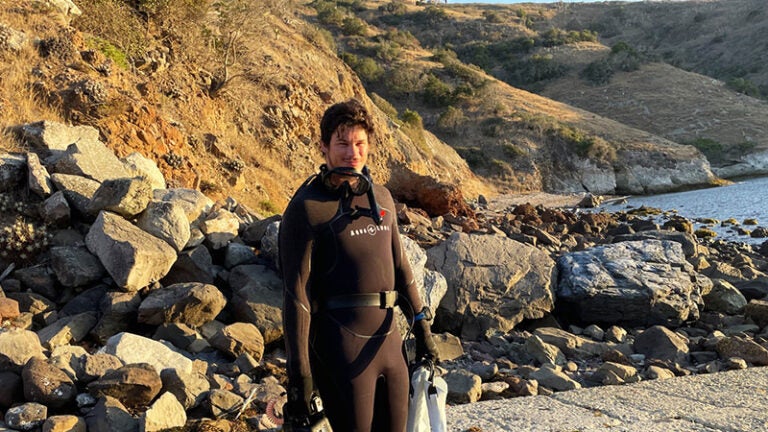
What’s in a photo? The potential to change the planet
In brief:
- The Environmental Communications Internship pairs students with scientists to help communicate lab research clearly and effectively.
- Students assist faculty with producing videos, writing articles and website content, taking pictures and other tasks that faculty may not be able to do.
- The program aims to prepare the next generation of scientific storytellers who can inspire the public’s interest in science.
On any given day this past summer, you’d find Yannick Peterhans on Catalina Island off the coast of Southern California, snapping shots of researchers and students or splashing through the water capturing scientific divers and sea bass beneath the water line.
For six weeks, Peterhans, who graduated last May with a degree in international relations from the USC Dornsife College of Letters Arts and Sciences, was the designated photographer and videographer for the USC Wrigley Marine Science Center.
The opportunity came through the Environmental Communications Internship offered by USC Dornsife’s Wrigley Institute for Environmental Studies, which pairs USC students with science labs that need a hand in communicating their work to the outside world. The program boosts students’ technical abilities and portfolios in skills like graphic design, helping prepare them for potential careers in scientific storytelling.
It’s work that is considered increasingly essential by scientists. Sharing research about pollution, climate change or other pressing environmental issues in compelling ways is vital to getting the public and the government to take action.
“Just throwing scientific facts at people doesn’t result in any change in thoughts or feelings about climate change. We need to weave better stories around science, to get people emotionally engaged,” says Carly Kenkel, Gabilan Assistant Professor of Biological Sciences, who hosted an intern in her lab this summer.
Mutually beneficial

Intern Alex Palakian designed a T-shirt graphic for a beach clean-up hosted by Megan Fieser’s chemistry lab. (Image: Courtesy Megan Fieser.)
Participants in the internship gained access to mentors, educational seminars and hands-on learning, along with a $5,000 stipend. Faculty in the program also benefited from the arrangement. Many don’t have the time or training to produce communications material about their research, so interns can fill in the gaps.
Alex Palakian, an environmental science and health major who worked with Megan Fieser, Gabilan Assistant Professor of Chemistry, wrote copy text for a new educational website on plastic pollution. He also produced graphics for her scientific publications. The illustrations help draw in readers and generate more engagement.
Fieser, whose lab focuses on finding ways to break down plastics, says this type of communication work can play a big role in keeping her research funded. “We increasingly rely on government funding, and elected officials provide that funding. If the American people don’t believe in science, then they won’t elect officials who support scientific funding,” she explains.
Interns learned how to tell stories to a wide range of audiences. In Kenkel’s lab, Shivani Gupta, a journalism major at the USC Annenberg School for Communication and Journalism, created a workbook on coral bleaching for grades K-12. They plan to distribute the book broadly, which includes QR codes that link to supplemental video interviews of researchers in Kenkel’s lab, produced by Gupta.
The content aims to be educational and inspirational. “It links stories about the real people doing the research and the projects they’re working on. You’re learning about the science, but you could also read this if you were curious about pursuing science as a career,” explains Kenkel.
If at first you don’t succeed …
For photographer Peterhans, who is pursuing a master’s degree in specialized journalism at USC Annenberg this fall, his internship helped him hone the ever-helpful skill of improvisation.
“I want to be a conflict photojournalist after college, and the ‘grab your camera and go’ style was the only way that we shot [at the USC Wrigley Institute],” says Peterhans. “Most mornings, I woke up and I didn’t know what I was shooting that day.”
The internship, funded by the Zinsmeyer family, who have long supported the USC Wrigley Institute through gifts such as The Zinsmeyer Family Endowed Undergraduate Research Fund, also taught Peterhans persistence, another skill important for field photography. He spent much of the summer attempting to track down the Channel Island fox, a shy creature that doesn’t make portraiture easy.
On the last day of his internship, he finally got his shot.

The elusive Channel Island fox finally made an appearance for Peterhans on the last day of his internship. (Photo: Yannick Peterhans.)